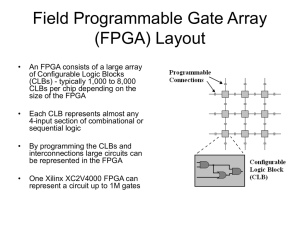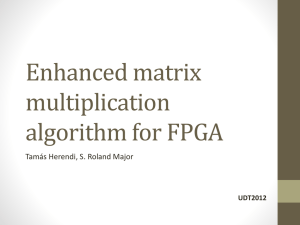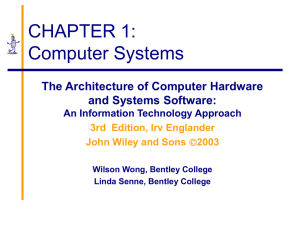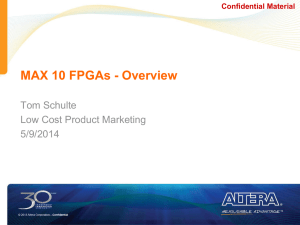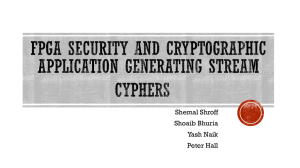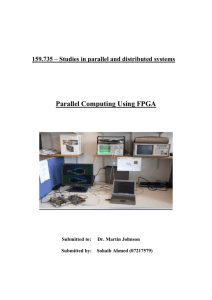Power
advertisement
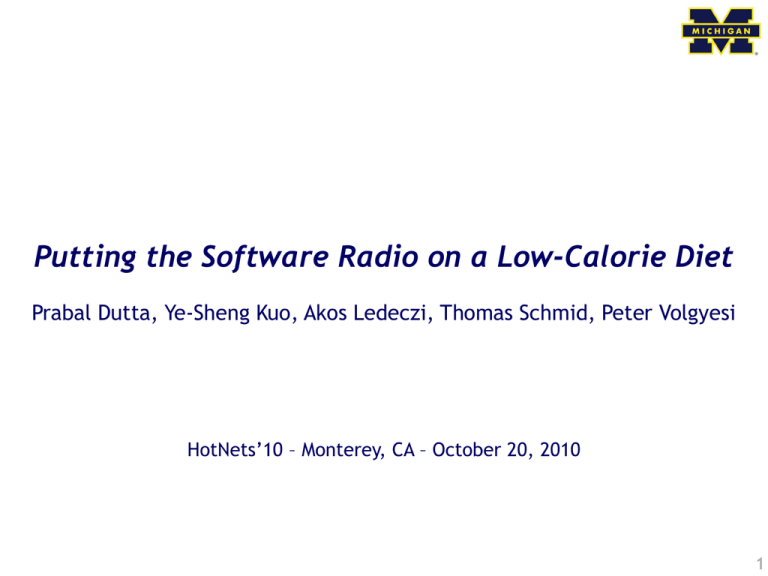
Putting the Software Radio on a Low-Calorie Diet Prabal Dutta, Ye-Sheng Kuo, Akos Ledeczi, Thomas Schmid, Peter Volgyesi HotNets’10 – Monterey, CA – October 20, 2010 1 Software radios have enabled novel directions in wireless research 2 Mobile and low-power wireless research has not benefitted as much from software radios Three SDR scaling challenges • Power (Active and Sleep) USRP Mote – A: USRP (10 W) vs Mote (60 mW) – S: USRP (10 W?) vs Mote (20 W) • Cost – USRP ($850) vs Mote ($65) – WARP cost >> USRP cost • Size – USRP (36 in2) vs Mote (1 in2) – WARP (64 in2) vs Mote (1 in2) 3 Imagine if we could build a small, inexpensive, and low-power software radio • Software radios that you could – – – – – Hold in the palm of your hand Embed in the physical world Deploy at very large scale Operate from solar power Hand out for student labs • Software radios that would enable – – – – – Mobile networking research Application-driven research Large-scale, in situ evaluations Energy-adaptive communications Hands-on learning 4 Addressing the size, power, and cost challenges will enable more natural deployment experiences 5 Outline • Introduction • Scaling Challenges • Technology Enablers • Architectural Sketch • Research Challenges 6 Challenge #1: Power • Low-power systems duty cycle – – – – – Attempt to achieve power proportional operation Architectures support power control High CPU and radio power draws Radio turned off or in standby CPU halted and put to sleep • SDRs cannot duty cycle – – – – – Fail to achieve power proportional operation Architectures do not support it Processor does not support sleep SRAM-based FPGA cannot sleep Radio power controls not exposed 7 Challenge #1: Power (or, why SRAM FPGAs are not power-proportional) • High in-rush current • High static power – Approximately 10x transistors needed – Increases with smaller transistors – Increases with lower Vth • High configuration current (and time) • Not amenable to efficient duty cycling 8 Challenge #2: Size (or, why modularity is expensive) • Conventional SDRs – – – – General-purpose Highly reconfigurable Modular platforms Large size • Reconfigurable Motes – – – – – Waldo Mote. Src: S. Lanszisera Application-specific Modestly reconfigurable Not modular Small size Examples • Waldo Mote • Bridge Monitor Bridge Monitor. Src: P. Volgyesi 9 Challenge #3: Cost (or, why discrete components drive up costs) • XC4VFX100-10FF1517C FPGA – 94,896 logic cells – $2400 • Radio board – – – – – – – MAX2829 Power Amp Ant Switch SMA I/F AD9777 AD9248 AD9200 http://warp.rice.edu/trac/wiki/HardwarePlatform 10 Summary of the scaling challenges • Power – SRAM FPGAs have high static power and cannot duty cycle – SDR architectures do not support power controls • Size – Modular designs are large and 3-dimensional – Discrete chips for RF and baseband pathways take up space • Cost – Ultra high-performance FPGAs are expensive – Discrete chips for RF and baseband pathways is costly 11 Outline • Introduction • Scaling Challenges • Technology Enablers • Architectural Sketch • Research Challenges 12 Emerging mixed-signal FPGAs (e.g. Actel SmartFusion) • Integrates – FPGA (200K/500K gates) – Hard CPU (ARM Cortex-M3) – Analog Compute Engine (ACE) • FPGA – Flash-based – Low-power – Logic tiles + SRAM blocks http://www.actel.com • CPU – 100 MHz+ operation – 64K SRAM / 256K Flash – FPGA memory-mapped on AHB • ACE – 600 ksps ADC/DAC – Fast comparators – Simple DSP operations 13 CPU and FPGA compute fabrics interfaced via AHB CPU FPGA Source: Actel SmartFusion MSS User Guide 14 Flash-based FPGA can be duty cycled • • • • • Low in-rush current Low static power (W) No configuration current No configuration delay Amenable to duty cycling • • • • “FlashFreeze” mode Clock domains suspended High-impedance I/O Memory contents preserved • Limitations • • • • Slow max speed (10-40 MHz) Lower gate count (130 nm node) Long reprogramming time (flash erase/write) Limited number of programming cycles (~1000) 15 Highly-integrated RF transceivers • Small layout size – Approx 150 mm2 – Including externals • Low-power – Active: ~200-900 mW – Sleep: ~30 W • High integration – – – – RF transceiver Integrated PA Integrated RX/TX SW Integrated diversity SW • ADCs/DACs – Integrated in FPGA – (at least slow ones) 16 Outline • Introduction • Scaling Challenges • Technology Enablers • Architectural Sketch • Research Challenges 17 Architectural sketch of a lean SDR platform • Mixed-signal FPGA – Flash-based matrix + PLL – ARM Cortex CPU (M1 or M3) – ADC/DAC/Analog Comparator • 2.4 GHz Radio – RF-to-baseband – Osc, Dig Frq Synth – PA, RX/TX Switch • Timebase – 32 kHz TCXO + DCO + VHT • Power – DC/DC converters – Energy metering • Optional – 40 Msps ADC / 40 MHz DAC 18 Addressing the scaling challenges • Power – SRAM FPGAs have high static power Use Flash-based FPGAs – SDRs do not support power controls Support Power Mgmt • Size – Modular designs are large De-modularize the design – Discrete chips take up space Leverage IC integration • Cost – High-end FPGAs are expensive Remove, complement with CPU – Discrete chips are costly Leverage integration, PCB Ant, … 19 A few other odds and ends… • Power-proportional timer system – – – – Offers virtual high-resolution time Balances fast-timer resolution (xx:34) …with slow-timer power draw (12:xx) Provides resolution on demand • Fast radio startup – – – – Accelerates sleep active transition Uses crystal to train ring oscillator Uses ring oscillator to kickstart crystal Balances high-Q and fast radio startup • Regulator-integrated energy meter – Supports application-level power profiling – Counts switching cycles of regulator – Transfers fixed energy quanta per cycle 20 Back-of-the-envelope evaluation Desc Mfg Part Size Cost Power (mW) FPGA Radio OSC PCB Power Actel Maxim Maxim 4PCB TI A2F200M3F MAX2830 DS32kHz 4-layer PCB Various 17x17 mm 7x7 mm 11x11 mm 38x63 mm 25x25 mm $40 $4 $4 $5 $5 TBD* 186/0.030 0.005/na na 20% overhead ADC DAC ADI Maxim AD9288 MAX5189 9x9 mm 6x10 mm $6 $5 156/6 7/1 Misc Various Various Various ~4 x 6 cm $31 n/a ~$100 ~350/10 * Actel IGLOO active power ~ 10’s mW and standby power ~10 W. * Actel SmartFusion power to be characterized. 21 Outline • Introduction • Scaling Challenges • Technology Enablers • Architectural Sketch • Research Challenges 22 Time multiplex algorithms on the CPU or parallelize algorithms on the FPGA fabric? FPGA • • • • • • • Verilog/VHDL RTLs Parallel Fast to run Hard to write Great power-efficiency Gate-limited Use soft CPU core? CPU • • • • • • • Assembly/C/C++ Sequential Slow to run Easy to write Poor power-efficiency Memory-limited Use hard CPU core 23 • • • • Lots of SDR & soft router software Better to not reinvent the wheel How can these libraries be wrapped? Implications on computation model? Click How should we reuse existing SDR libraries? http://gnuradio.org/redmine/repositories/browse/gnuradio/gnuradio-core/src/lib 24 Let chaos reign… then rein in the chaos • Many basic architectural questions – How much low-level detail should be exposed to applications? – How to balance component library flexibly and reuse? – How should computations be scheduled? • But many questions don’t need immediate answers – Allow exploration of the design space – Allow competing software architectures – Eventually converge on known good design points 25 Outline • Introduction • Scaling Challenges • Technology Enablers • Architectural Sketch • Research Challenges 26 This work is about finding a middle ground USRP SDR Mote 27 Questions? Comments? Discussion? 28



